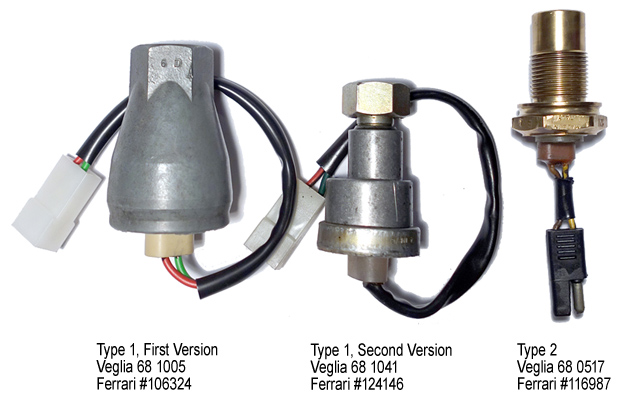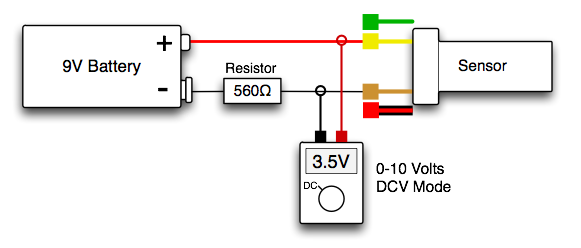Veglia Borletti Speedo Sensors Diagnose and Repair |
|||||||||||||||||||||||||||||
| << back |
This page discusses early Veglia Borletti speedo sensors, as used in Ferrari, Maserati and Alfa Romeo cars from 1974 to 1999.
There are three sensor versions, each one with a different body design. All three sensors have the same functional principle and electronic circuit design. |
||||||||||||||||||||||||||||
Introduction The speedo sensors discussed here are inductive proximity sensors, they create an electromagnetic field that is influenced by a passing metallic object (as example, a small reluctor or a gearbox wheel). The magnetic field collapses as long as a metallic object is in front of the sensor, the on board transistor circuit then changes the output to low. Type 1 Sensor, First Version 1974-1976 (Veglia 68 1005, Ferrari #106324) This is the first speedo sensor design, it has been superseded by Veglia sensor 68 1041 in 1976. Both sensors are interchangeable. The earliest cars deployed with this sensor were the '74 Ferrari 365 GT4 and 308 GT4. A common problem is oil seeping in through the speedo cable seal, the oil can then damage capacitor C1 or C2. Disassembly Gently bent the crimped border upwards (the body material tends to be somewhat brittle), then remove the ring and white cover/wires with the circuit board below for doing a repair. To remove the circuit board from the white plastic cover you need to unsolder the two wires in the middle of the circuit board. Sensor Circuit Board & Diagram 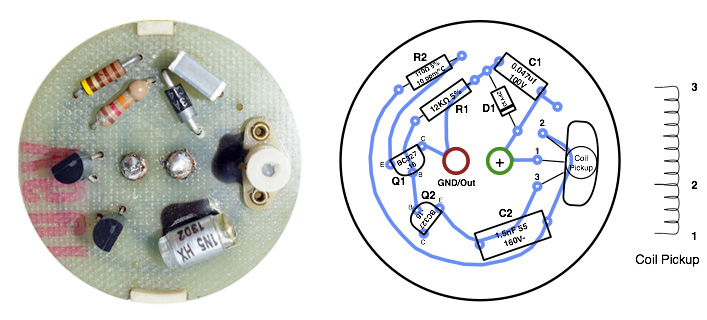 Type 1 Sensor, Second Version 1976-1980 (Veglia 68 1041, Ferrari #124146) This sensor type replaced the previous 68 1005 sensor, both have the same circuit, speedo cable stub and nut, but a different body design. Early versions had the red/black stripe (signal) and green (+12V) wire colors of the previous type 1 sensor, later sensors changed to brown (signal) and yellow (+12V) wire colors. Disassembly For access to the circuit board the top of the crimped ring needs to be gently levered off, then the wire and white plastic cover/wires with the circuit board can easily be removed for repair. To remove the circuit board from the white plastic cover you need to unsolder the two wires in the middle of the circuit board. The board/components are covered with a thin layer of silicone seal, which can be easily removed with a knife tip, small screwdriver or needle. Sensor Circuit Board & Diagram 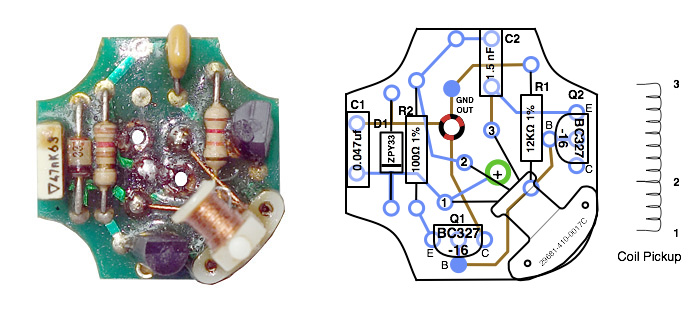 Type 2 Sensor 1980-1999 (Veglia 68 0517, Ferrari #116987) This is the third Speedo sensor version, it is somewhat similar to modern speed sensors. The Ferrari 355 was the last Ferrari using this sensor type. There are no moving parts on this type, the pickup coil is embedded in the black plastic covering the open end of the brass body and pointing towards a gear wheel in the gearbox. Disassembly The circuit can be accessed by first prying off the crimped brass border at the rear end of the sensor body, then remove the white top/circuit board/coil assembly from the sensor body by pushing in the black coil sensor at the open end. Heating up the sensor body with a heat gun helps if the sensor circuit is stuck. Sensor Circuit Board & Diagram  Diagnose and Repair If the test procedure above was not successful, disassemble the sensor and remove the board as explained above. Repair Procedure 1. Check all solder joints and components Bad solder joints are not an uncommon problem, especially with the early sensors. Visually check all solder joints and carefully resolder them where necessary. Soldering flux helps considerably when handling corroded pcb traces. If you suspect a cold solder joint somewhere, wire up the sensor current test setup shown below and gently apply pressure to all components to see if the current changes. Also check all components for cracks or other damage, replace where necessary. Repeat the voltage test from above, or the sensor current test shown below. 2. Test the pickup coil resistance Using a good multimeter in low resistance (Ohm/Ω) mode, measure the pickup coil resistance between the three solder pads (for location see the sensor circuit board diagrams above, you can measure the coil in situ). You should see the following values if the pickup coil is ok: If one of the (1) - (2) or (2) - (3) measurements return a much higher or open resistance value, try resoldering the coil wires to the solder pads. If this did not fix the problem, try rewiring the coil pickup if it's a type 1 sensor (see below). Repeat the voltage test from above, or the sensor current test shown below. 3. Replace components If solder joints and coil pickup resistance values are both fine, continue by exchanging the two BC327 transistors (Q1, Q2). If this did not fix the sensor, also exchange the two capacitors (C1, C2). If this still did not fix the sensor you might also try replacing both resistors (R1, R2) and the zener diode (D1), although these rarely break. After repairing the board it is recommended to treat the component side with "Silicone Conformal Coating" spray for two or three times as a protection against oil and humidity before reassembling the sensor. Sensor current test: a helpful test setup while doing a repair is measuring the current uptake of the sensor. A functional sensor will have an DCA current consumption of around 1-2 mA without a metallic object in front of the sensor and around 10 mA with a metallic object present, when tested with a 9V battery as shown below. 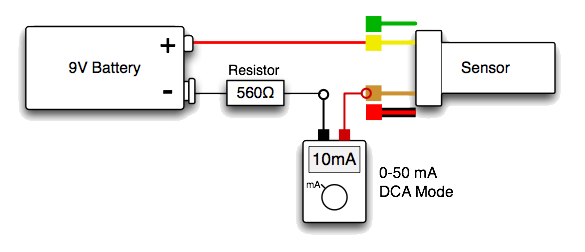 Pickup Coil Repair On type 1 sensors the pickup coil can be rebuild if broken. You need around 40 cm of silk insulated "litz" stranded wire, as used for rewinding high frequency coils and transformers. I am using 10x0,05 mm² HF stranded wire for pickup coil rebuilds. The coil winding consists of two segments, one winding with a length of 5 cm between solder pad (1) and (2), and another winding with a length of 30 cm between solder pad (2) and (3) (see individual component diagrams above for locations of each solder pad). Remove the old coil wiring from the pickup body. Start from the left with the connection to solder pad (1), then wind 5 cm of wire clockwise around the pickup body. Connect the wire to solder pad (2) and continue winding the remaining 30 cm clockwise. Solder the end of the wire to solder pad (3). Fix the position of the coil windings with silicone spray or a bit of clear paint. Circuit Diagram and Component List The collector of transistor Q2 is left open, this is correct as Q2 is wired up as a base-emitter diode. 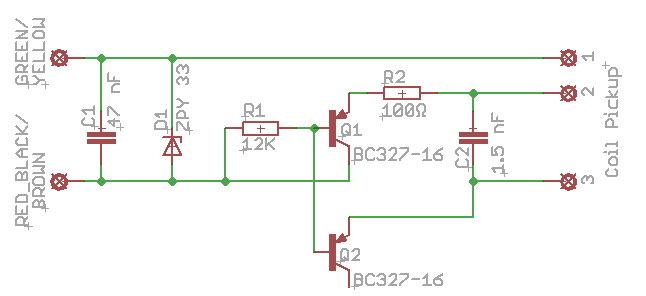 Component List 
Scope Signal Images Magnetic field resonance at 1.47 MHz, measured at coil pickup wire: solder pad (3) (yellow trace) and solder pad (2) (cyan trace). With a metallic object in front of the sensor the signals above will change into a DC voltage (flat line). Sensor output signal (Red/Black or Brown wire) measured in the test circuit shown above or with the Speedo connected |
|||||||||||||||||||||||||||||
